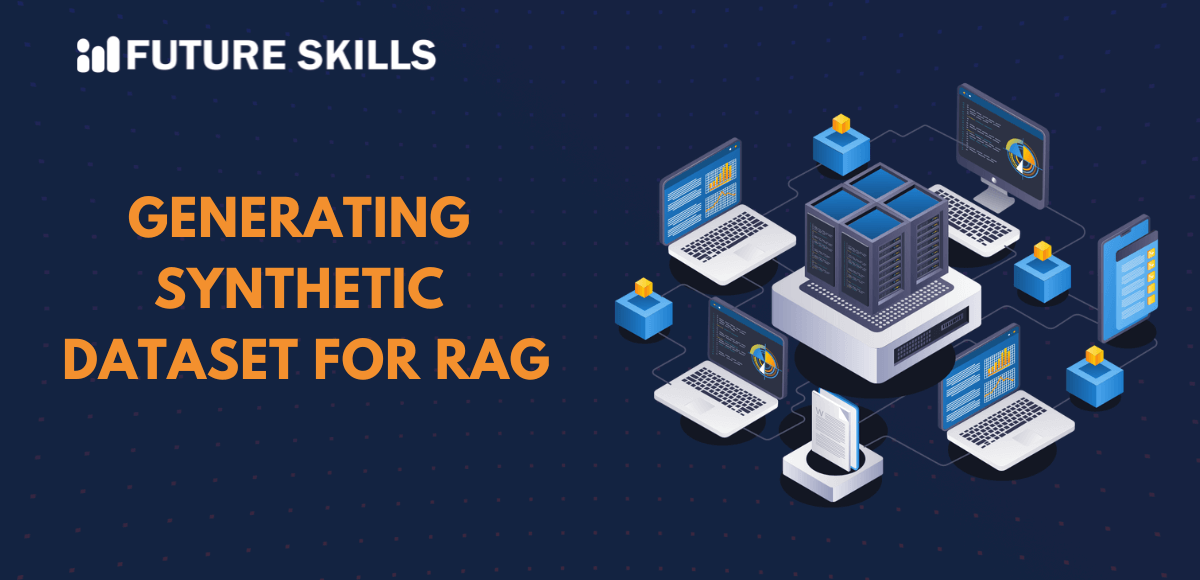RAG (Retrieval-Augmented Generation) is an effective technique for improving the reliability and precision of generative AI models whose facts have been extracted from external sources. The role of RAG is fundamental to influence how large language models (LLMs) function. With the help of RAG it is possible to optimise a large language model. By using RAG, it is possible to fuse LLMs with external sources in order to enhance their output. In the technology-driven setting, RAG is a ground-breaking invention, to say the least.
In the realm of Machine Learning (ML), the significance of synthetic dataset for RAG cannot be negated. The evaluation of RAG is an extremely important step for every Machine Learning Engineer. If you wish to build your career as an ML Engineer, you need to know how to generate synthetic dataset for RAG. It can help you measure the performance of your RAG while you are creating such types of systems. If you wish to take up a career in machine learning, you need to learn about generating synthetic dataset for RAG.
In case you are wondering why generating a synthetic dataset for RAG is necessary, then you must know that it can help provide valuable quantitative feedback. With the help of the feedback, you can assess your RAG and move ahead in your experimentation. If you want to make the most of the RAG concept you need to address the question relating to how to generate synthetic data.
Make the most of AI technology by learning how to write precise prompts with our leading Prompt Engineering Certification Course offered for every AI enthusiast.
Benefits of RAG over conventional LLMs
It is true that large language models are immensely popular in the Artificial Intelligence and Machine Learning realm. However, organisations face a host of challenges while relying on LLMs. Some of the common challenges are the risk of using incorrect information, the generation of outdated information and many more. This is when RAG comes into the picture.
RAG models are a scalable option in comparison to LLMs. Moreover, RAG is also cost-efficient. Instead of relying on the entire web, RAG sources contextual appropriate solutions from trusted sources. Hence by using RAG models instead of LLMs, the level of trustworthiness gets improved.
Now that you know the benefits of RAG, you may be wondering how RAG synthetic data generation is relevant. The answer is simple. You can strengthen RAG models with the help of synthetic data. Such type of data can contribute towards data collection as well as knowledge expansion, and retrieval optimization along with the tuning LLMs. Now the main question that you may have is – how to generate synthetic data for RAG.
Generating synthetic dataset for RAG
There exist a number of synthetic data generation methods for RAG. However, you can choose the method that you find to be ideal for your needs. One of the main ways of generating synthetic dataset for RAG involves the use of open-source models. You need to choose the appropriate open source model that seems fit to generate synthetic data from real data.
Usually, a RAG system encompasses two key components that require optimization. The first component is the generation component, and it includes elements such as the prompt template, large language model (LLM), etc. The second component is the retrieval component, and it consists of a vector index, embedding model and reranker.
During the RAG synthetic data generation, it is fundamental to focus on these components. For evaluating these components, you require a series of questions as well as ground truth solutions to the questions. The step-by-step focuses on the use of Ragas to generate synthetic data from real data.
-
Loading the knowledge base
The initial step involves loading the raw data. It is a crucial step from where you can create the evaluation set.
-
Model set up
In the next stage of generating synthetic dataset for RAG you need to focus on the setting up of the models. It is essential to keep in mind that you require three models at this stage. The first model is a generator model, and you will be required to generate the question and answer pairs. Furthermore, you must ensure that these pairs are in sync with the given context.
The second model that you require for generating synthetic dataset for RAG is the embedding model. This model will help in the generation of embeddings from the available raw data. The final model is the critic model. This model is necessary for validating the generation process. In order to successfully generate synthetic data from real data, this is a basic step that you need to keep in mind.
-
Use of RAGs Test Set Generator
Now it is time to utilize RAGs Test Set Generator. Since it encompasses all the three models – generator, embedding and critic models, you need to use it. Moreover, by using RAGs Test Set Generator you can set out the distribution of the data that has been generated. You can ascertain the examples that need to be in the form of simple questions and answers. Similarly, you can also determine the number of examples that need to focus on reasoning.
-
Loading data
The creation of the test set is fundamental in synthetic data generation methods for RAG. After you are done with the step you need to shift your attention to loading the test set as a data frame. It is a crucial step in the RAG synthetic data generation process. After loading it you can analyse the same and save it in the appropriate format such as csv so that it can be evaluated at a later stage. This step is vital to effortlessly generate a synthetic test set.
The proper use of the ragas framework is fundamental to simplify the generation of synthetic data from real data. It is undoubtedly one of the ideal synthetic data generation methods for RAG. This is because it supports the automation of tedious processes. That’s not all! By leveraging the framework developers have the liberty to specify the distribution of the generated data.
Discover the working of LLMs and learn about different language models with this comprehensive LLMs comparison guide.
Importance of synthetic data in RAG Models
If you want to make the optimum use of RAG models, it is essential for you to know how to generate synthetic data. The insight can definitely help you make optimum use of RAG. By using synthetic data, the augmentation of RAG models is possible. Some of the key benefits that can arise by using robust RAG models are:
-
Relevance in terms of context and domain
A fundamental benefit of using RAG models is that these models enhance contextual as well as domain-related relevance. By using external sources, it is possible to reap this benefit. RAG models are ideal when it comes to specialising queries.
-
Reduction in hallucinations
The risk relating to hallucination revolves around false or inaccurate information. It can act as a major source of concern. In the case of RAG models, the use of information updates in a dynamic manner eliminates such risks. Hence there is a reduction in the possibility of generating inaccurate content.
-
High scalability and cost-efficiency
One of the obvious benefits of RAG models involves high scalability. Undoubtedly, these models provide scalable knowledge integration options. Moreover, there are also the options to customise the generation of responses. Furthermore, RAG models are much more cost-efficient in comparison to large language models.
-
Modular creation of question and answer pairs
By using the RAG model, you can generate question and answer pairs in a flexible manner. By making use of diverse models, the precision as well as the effectiveness of the responses can be enhanced.
If you wish to make the most of RAG models, it is essential to know how to generate synthetic datasets for RAG. The process will help you strengthen the overall effectiveness of the model.
Learn how to use AI and generative AI skills in your business or work with our AI for Everyone Free Course. Enroll now!
Final Words
In the Artificial Intelligence realm, RAG is an important technique for boosting the reliability and accuracy of Generative AI. However, for making the optimum use of RAG models, it is instrumental to know how to generate synthetic data from real data. In case you have limited insight into the area, you do not have to feel overwhelmed. You can refer to the simple guide to understand how you can generate a synthetic dataset for RAG. It is a key step that can help augment the effectiveness of the RAG model.
A number of important dimensions have been covered including the benefits of RAG over conventional LLMs and the steps for generating synthetic dataset. Furthermore, the importance of synthetic data in RAG models has been explained. If you wish to derive maximum benefits from RAG models, it is a must to utilise synthetic dataset.
This dataset has the potential to enhance the performance of RAG models. By effectively generating synthetic data for RAG, you can derive maximum benefits from the model. Some of the main benefits of using RAG are context and domain-related relevance, decrease in hallucinations, high scalability and cost-efficiency, and modular creation of question and answer pairs.







